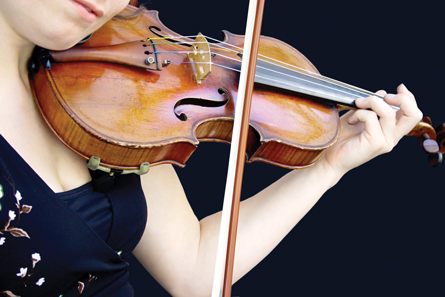Module 8—Mechanical Waves
Lesson 3—Wave Phase, Interference, and Standing Waves
 Get Focused
Get Focused

© Denis Pepin/shutterstock
In Lesson 2 you learned that when a wave encounters a boundary, it is reflected in a very predictable way. With the right equipment, this fact helps geologists understand the physical makeup of the boundaries below Earth’s surface. Can the same principles of wave reflection be applied to help you understand the notes produced by a stringed musical instrument, such as a violin or guitar?
When a musician disturbs the fine strings of a violin, the strings vibrate and produce a wave that propagates along the string.
The wave quickly encounters a boundary, either the musician’s fingers or the physical end of the string. At this point, the wave is reflected back along the string, even though the strings are still being disturbed by the musician. This means the reflected wave will encounter more waves travelling in the opposite direction. What happens to the string when two waves encounter one another while travelling in opposite directions? Will they interfere with one another to produce a new wave? Will they pass through one another undisturbed? How is this interaction and resulting pattern sensed by your ears? How exactly is wave reflection and interference related to music?
As you work through this lesson, keep the following questions in mind:
- How can waves be described using phase and phase angle?
- What is constructive and destructive wave interference?
- What is wave superposition?
- What is a standing wave? How is this related to musical tones?
 Module 8: Lesson 3 Assignments
Module 8: Lesson 3 Assignments
Your teacher-marked Module 8: Lesson 3 Assignment requires you to submit a response to the following:
- Try This—TR 1, TR 2, TR 3, TR 4, TR 5, TR 6, and TR 7
- Discuss
You must decide what to do with the questions that are not marked by the teacher.
Remember that these questions provide you with the practice and feedback that you need to successfully complete this course. You should respond to all the questions and place those answers in your course folder.